If you get my notes via email, you may have received a draft of this one in September. I was trying to schedule posts in advance for the weeks I knew I wasn’t available, but I accidentally sent it early. Ooops.
I pre-scheduled this because right now I am locked in a rehearsal room in downtown LA working on this play. I did a small reading of it in NYC in October, which was like placing a pillow under its head and asking if it wants some warm milk. Right now, however, I’m gouging it with a hunting knife and ordering it not to bleed on my nice white carpet.
Why?
Because it’s a one-person play.
I don’t like one-person plays.
For one, they invoke in me a sort-of empathetic claustrophobia for the performer. “That poor gal is stuck on that stage for a whole hour with no air! Get her out of there!”
But my bigger issue, I think, involves my struggle as an audience member to understand my role in the narrative.
Like, if the character is talking to a literal theatre audience, as with my friend Heidi’s play, I get it. I bought a ticket and sat down and now a performer named Heidi is talking to me about stuff she cares about. My job is to pay attention to her.
I can do that. Heidi’s amazing. The show is great. Easy peasy.
And in McNally’s Master Class, which I saw at the Taper in LA a bazillion years ago, we are cast as Maria Callas’s students. My “purpose” in that audience is to stay silent and worship her so she can react.
I’ve been a devoted disciple. I know how to worship a legend. Done and done.
Underneath the Lintel by Glen Berger, Soho Playhouse, NYC 2001. A librarian gives a lecture about a book that was returned 113 years late. My role is pretty clear. I’m a person who showed up to a lecture about a book. My character likes books. Perhaps I have lots of free time. I’m… enterprising? Educated?
Check.
The Object Lesson at the Kirk Douglas in Culver City two years ago. We’re literally moving boxes and sharing food and dancing with Geoff Sobelle’s character. We have jobs! We help him build the event of the show. He can’t make his play without us. He’d have no one to dance with.
I’ve only ever read 4.48 Psychosis by Sarah Kane ’cause when it was at St. Anne’s in Brooklyn four years ago I was feeling maybe not totally emotionally prepared for it, but in it you witness a young woman’s mental collapse on stage. Your role is almost opposite to The Object Lesson; she would fall apart even if you weren’t watching. You’re basically there to hold the stories of the woman who can’t. You’re the survivor.
I’ve been a survivor. I know how to do that.
However.
When I can’t tell who I am as an audience, I get a little um nervous.
Like when the character on stage is a just a person telling horrific or humorous or meaningful stories. I’m like, did I just casually wander into a trauma circle? Why is only one of us talking?
(Is that crazy?)
I loved Will Eno’s Thom Pain at the DR2 in 2005 (didn’t see the recent revival at the Signature, sadly). I looked it up for the character breakdown:

In this show I play an anonymous passive observer cloaked in a temporary theatrical convention. Ok… but why does Thom need me there? What am I doing?
Same with Buyer and Cellar by Jonathan Tolin, which I saw at the Taper. An out-of-work actor named Alex talks about the time he got hired to work in a basement mall at Barbra Streisand’s house. He’s telling me about it because… I have no idea. Am I his friend? Are we having coffee? Why isn’t he asking me about the bleeding gash above my left eyebrow?
I don’t have a gash. But if I did, he wouldn’t ask about it.
(Am I the only person who’s been hurled into an existential void over this??)
For some reason I don’t have this problem when the performer portrays multiple characters connected by a central theme. Like with Danny Hoch’s show about gentrification called Taking Over, or Heather Raffo’s Nine parts of Desire dealing with the plight of Iraqi women.
I saw neither of these. I looked them up.
‘Cause I’m writing a one-person show, man.
By choice.
I don’t know what the fuck I’m doing.
The structure of my play hangs on an actual yoga class. Before the show begins, play-goers are invited to participate on-stage where they remain until the performance ends. They are “yoga students.”
But my character only addresses those people. She doesn’t address “the audience” at large, who is crouched behind the ol’ fourth wall.
Who the hell are they?
Am I writing a hybrid between a traditional play and an object lesson?
Do I need to account for the relationship between on-stage audience and in-house audience?
